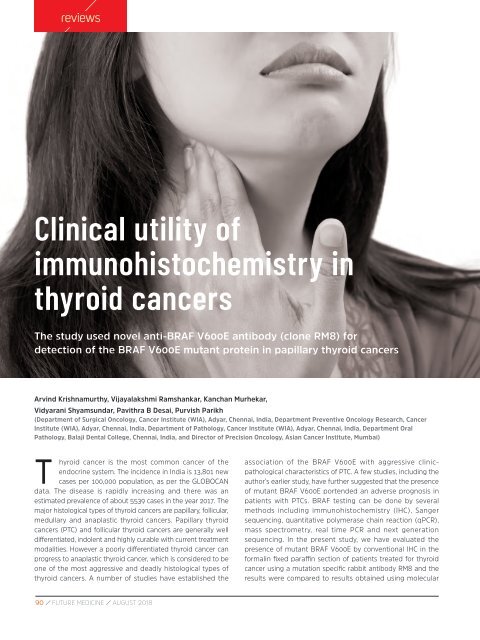FM AUGUST 2018 ISSUE1 - digital edition
You also want an ePaper? Increase the reach of your titles
YUMPU automatically turns print PDFs into web optimized ePapers that Google loves.
eviews<br />
Clinical utility of<br />
immunohistochemistry in<br />
thyroid cancers<br />
The study used novel anti-BRAF V600E antibody (clone RM8) for<br />
detection of the BRAF V600E mutant protein in papillary thyroid cancers<br />
Arvind Krishnamurthy, Vijayalakshmi Ramshankar, Kanchan Murhekar,<br />
Vidyarani Shyamsundar, Pavithra B Desai, Purvish Parikh<br />
(Department of Surgical Oncology, Cancer Institute (WIA), Adyar, Chennai, India, Department Preventive Oncology Research, Cancer<br />
Institute (WIA), Adyar, Chennai, India, Department of Pathology, Cancer Institute (WIA), Adyar, Chennai, India, Department Oral<br />
Pathology, Balaji Dental College, Chennai, India, and Director of Precision Oncology, Asian Cancer Institute, Mumbai)<br />
T<br />
hyroid cancer is the most common cancer of the<br />
endocrine system. The incidence in India is 13,801 new<br />
cases per 100,000 population, as per the GLOBOCAN<br />
data. The disease is rapidly increasing and there was an<br />
estimated prevalence of about 5539 cases in the year 2017. The<br />
major histological types of thyroid cancers are papillary, follicular,<br />
medullary and anaplastic thyroid cancers. Papillary thyroid<br />
cancers (PTC) and follicular thyroid cancers are generally well<br />
differentiated, indolent and highly curable with current treatment<br />
modalities. However a poorly differentiated thyroid cancer can<br />
progress to anaplastic thyroid cancer, which is considered to be<br />
one of the most aggressive and deadly histological types of<br />
thyroid cancers. A number of studies have established the<br />
association of the BRAF V600E with aggressive clinicpathological<br />
characteristics of PTC. A few studies, including the<br />
author’s earlier study, have further suggested that the presence<br />
of mutant BRAF V600E portended an adverse prognosis in<br />
patients with PTCs. BRAF testing can be done by several<br />
methods including immunohistochemistry (IHC), Sanger<br />
sequencing, quantitative polymerase chain reaction (qPCR),<br />
mass spectrometry, real time PCR and next generation<br />
sequencing. In the present study, we have evaluated the<br />
presence of mutant BRAF V600E by conventional IHC in the<br />
formalin fixed paraffin section of patients treated for thyroid<br />
cancer using a mutation specific rabbit antibody RM8 and the<br />
results were compared to results obtained using molecular<br />
90 / FUTURE MEDICINE / <strong>AUGUST</strong> <strong>2018</strong>


















